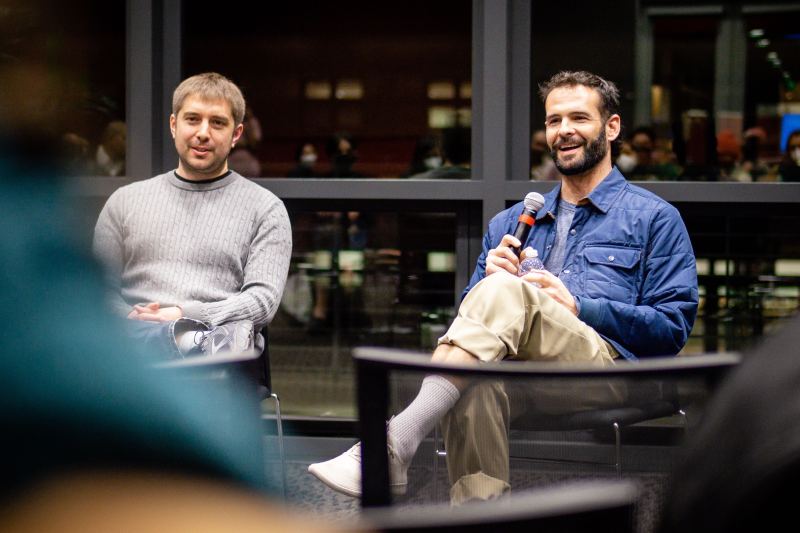“I’m so excited about the fact that we’ve brought our words into the engineering quad,” said Nick Jenkins, interim director of Stanford’s creative writing program, in his introduction to the first Stegner Fellow Reading of the year, sparking laughter from the audience. Thus, Jenkins ushered in the first Stegner Fellow reading of the academic year on Nov. 16 at the Huang Engineering Center.
The Wallace Stegner Fellowship is a two-year-long program designed to allow promising writers to develop their work and attend workshops with Stanford creative writing faculty. It is awarded to five poets and five fiction writers each year. Stegner Fellow Readings are held for the public throughout the academic year featuring first-year Stegner Fellows and their work.
Tuesday’s reading featured fiction writer Francisco González and poet D.S. Waldman, both first-year Stegner Fellows. González’s work has been featured in Arts & Letters, Gulf Coast and The Southern Review; his short story “Clean Teen” won the O. Henry Prize this year. Waldman is currently a poetry editor at The Adroit Journal, and his work has been published in Kenyon Review, Lithub and Narrative.
González and Waldman answered audience questions about their writing processes, sources of inspiration and stylistic decisions. Both were candid about the frustration of writing. It took González three months and 12 drafts to get to the version of the manuscript he read. “I’ve become very comfortable with tears,” quipped Waldman. Describing how he approaches writing, González said, “I try to take note of things that are both funny and sad and make a big pile of them, and maybe that turns into a viable story.” In his writing, he explained, the most serious passages are often also the ripest for humor. Waldman’s process is based on the act of writing itself, “the literal physical movement of putting pen on page might come before the idea,” he said.
González read from an untitled short story about an undocumented man who sets out to find an American citizen to marry. He ends up dating Stephanie, a mysterious ex-convict. González uses humor brilliantly in the work, able to make the audience frequently laugh out loud while simultaneously confronting challenging realities. At one point, reminded of his parents’ troubled relationship while considering the prospect of a green card marriage, the narrator says, “As a child, I thought of marriage as something bad that would happen to other people but not to me.”
The narrator’s anxiety about deportation is a constant presence throughout his relationship with Stephanie. He describes sometimes sleeping fully clothed in case he needs to flee his apartment in the middle of the night. An important aspect of being with Stephanie is that it offers him a feeling of protection: “having a white woman on my arm made me bold. It was like wearing a powerful disguise,” he says. González attunes the audience to the irony of this feeling; Stephanie was in prison and continues to wear an ankle monitor, after all.
For the narrator, “proximity to whiteness” is an assurance of safety, and he pursues it through Stephanie in spite of visible red flags, such as her brutal bluntness and unwillingness to reveal her past. A subtle sense of doom builds as the story progresses, and the narrator’s willful blindness becomes increasingly clear. Through the relationship between the narrator and Stephanie, González explores the precarity of being undocumented and the risks and costs of attempting to assimilate.
Waldman took the stage second, reading “Poetics of Failure,” a lyric essay that evolved from his Stegner Fellowship personal statement, and two poems entitled “Virga” and “Calder.” “Poetics of Failure” defines the “aesthetic framework” of Waldman’s poetry, discussing two personal experiences that have shaped his work: the death of his brother and the antisemitism he confronted while growing up in Kentucky.
“In every poem, there is a ghost,” Waldman read, describing that indescribable presence that lingers beneath poems. Because of the limitations of language, Waldman sees every poem as, in some sense, a failure; yet the very act of confronting those limitations time and again is a life-affirming act of rebellion.
In “Virga,” (a meteorological term describing rain or snow that evaporates before hitting the ground) Waldman explores grief against the backdrop of Eastern Oregon. “I don’t make any sense in the high desert,” he begins the poem, “Prayers going out like prayers into a sky too big to answer.” With these lines, Waldman articulates the grieving speaker’s profound helplessness, compounded by the indifference of his natural surroundings.
The San Francisco Museum of Modern Art was another source of inspiration for Waldman — he made notes for “Calder” while viewing Alexander Calder’s mobiles on display there. The poem describes the speaker’s response to the art: “the thing about art, and especially three-dimensional art, is I expect it always to teach me how to live in a body.” Waldman explores the theme of disconnect throughout the poem, whether between mind and body or self and surroundings.
“At a party, I look up and realize suddenly that I’m the oldest in the room by a mile, which is not a measure of time, I know, but of distance,” Waldman read.
The next Stegner Fellow Reading will take place on Nov. 30, featuring Faith Merino and Jade Cho.
Editor’s Note: This article is a review and includes subjective thoughts, opinions and critiques.
